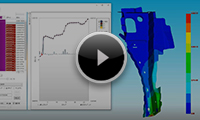JWELD Functions
JWELD is a software-evaluation system that combines the effects of various tooling and joints handled at production sites. It helps simulation to improve a variety of production challenges.
Without finite element analysis expertise, Japanese set window allows you to easily create a model. This allows simulation electors to take advantage of the fact that they are not present at the manufacturing site.
- Reproducing the production manufacturing step in the field of connection/assembly to your computing environment
- Two simulation features, fusion welding simulation and Friction Stir Welding (FSW) simulation
- Easy-to-use Japanese interface
Fusion welding simulation (Thermo-elasto-plastic method): Welding Designer
JWELD Welding Designer is a simulation feature for fusion welding such as arc-welding and laser welding.
Detailed temperature histories near weld pool can be obtained using Thermo-elasto-plastic analysis method, which sequentially calculates heat input to the weld and weld bead generation.
It also predicts not only the weld thermal deformation but also residual stress distribution around the weld.By combining phase transformation solver, which is a standardized function, microstructural change of HAZ (heat affected zone) due to welding thermal history can be predicted, and the weld effect of steel that requires fine component tuning, such as high-strength steel and tool steel, can also be evaluated in advance.
Prediction of Residual Stress
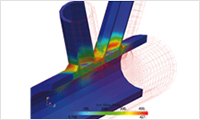
Predicting weld deformation
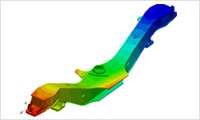
Various heat source models
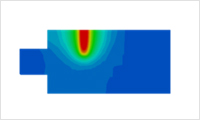
Fusion welding simulation : Welding MEGA
Welding MEGA is a simulation feature suitable for large-scale fusion welding such as large structure and thin plate constructions.
A built-in "JWELD lhsm" solver jointly developed by JSOL based on the inherent strain simulation solver "JWRIAN" developed by Joining and Welding Research Institute, Osaka University can predict deformation when welded in minutes.
It uses a calculation method for thin plate called shell element and has the advantage that the calculation time is only a few minutes. It is suitable for calculating large structure structures such as ship hulls, plants and tanks, as well as thin plate structures such as automotive and construction equipment frames.
The Optimal Calculation function also supports consideration of welding sequence that can reduce thermal deformation and improve yield rate. Welding MEGA automatically creates a weld manufacturing step from the robotic robotic welding programming data and examines how to reduce deformation by changing welding sequence using optimization solver.
Inherent strain database
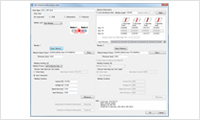
Importing robotic welding programming data
Supported robotics: KRANENDONK Rinas Weld, Kawasaki Heavy Industries KCONG, Panasonic DTPSIII
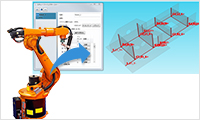
Optimization welding sequence
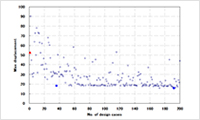
Fusion welding simulation : Welding Scheduler
Welding Scheduler is a simulation feature suitable for deformation forecasting on casting and forging.
Inherent strain method's thermal deformation analysis software, which uses residual strain of Thermo-elasto-plastic analysis by Welding Designer, uses the calculation element for thick-walled products called solid element, which differs from Welding MEGA.
Partial modeling for thermal elastoplastic calculations and the handover of residual strain results can be easily set up with GUI for Welding Scheduler, and welding sequence can be studied using the speed of calculations that are characteristic of Inherent strain method.
Simple takeover of residual strain
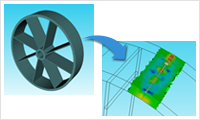
Friction Stir Welding simulation :Friction Stir Welding (FSW)
JWELD FSW (Friction Stir Welding) is a simulation function for Friction Stir Welding.
It consists of two calculation functions: a function to calculate stirring phenomenon around tool and a function to calculate the junction deformation using heat generated around tool.
Tool's rotational rate and bonding rate alone predict the joinability and calorific value from the agitation conditions around tool. This is a complete simulator of Friction Stir Welding that can predict heat deformation and residual stress based on predicted calorific values. It is expected to be used to control internal defect, evaluate heat input conditions, and reduce tool reaction force, which is a FSW issue.
Complete simulator
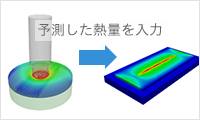
Predicting material Agitation around tool
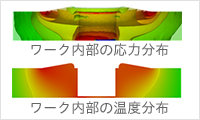
Spot welding assembly simulation :Spot Welding
Spot Welding is a simulation function intended for assembly manufacturing step of resistance spot welding.
By using JSOL's proprietary spot welding specific strain simulation*, deformation of the assembly manufacturing step including spot welding can be predicted in a short time.
The calculation method used for thin plate by shell element of Welding MEGA and similar is used, and it is characterized by short calculation times. Predicting manufacturing step assembly deformation enables pre-evaluation of the post-assembly geometry, checking deformation history of individual manufacturing step, and studying ways to improve manufacturing step.
A GUI dedicated to spot welding supports simulation sets such as auto-generation of dots, manufacturing step defnitions such as clamp, and manufacturing step administration.
※Patented (patent 6985689)
Automatic generation of dots
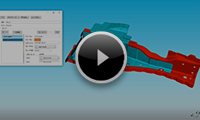
Manufacturing step Definitions/manufacturing step Administration
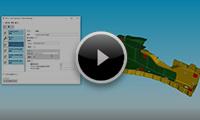
Deformation history check for each manufacturing step
